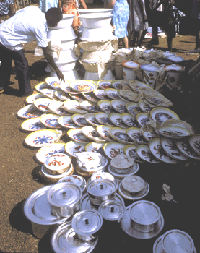 |
The Foya traditional week market | |
|
|
|
|
|
We start our trip in Monrovia, the Liberian capital and travel by car to Foya, also called Foya Kamara / Foya Airfield. Foya is located in the North West of Liberia, near the three country point between Liberia, Guinea and Sierra Leona, about 450 km from Monrovia. See attached map of Liberia. In the 1970s the trip Monrovia – Foya took at least eight hours by car. The first 100 kilometers leading away from Monrovia were paved. One kilometer after the country house of former President Tubman of Liberia the asphalt pavement suddenly stopped. The remaining 300 Km to Foya was a graded laterite road; with a undulating washboard type of surface, hence the name “washboard” road. During the seven months of the dry season, from November to May, one could drive on this road with a speed of up to 90Km/hour, but one was constantly traveling in a cloud of red laterite dust. During the rainy season the speed was slower, due to the many potholes in the road. In general the road condition was poor and one had to face flat tires frequently, which had to be repaired on the spot, using a hot patch and the car’s engine to obtain air pressure. There were no tire repair shops along the entire road! Foya town located, in the centre of the Liberian Kissi tribal area, had an important weekly market in the 1970s. The Saturday Foya market day was a very colorful happening and had an important regional economic function. In our market survey we estimated that an average of between 5000 and 7000 persons participated each market day. Most of these were local farmers, while there were also several hundreds of traders. In addition to local Kissi traders, who bought and or sold local agricultural commodities, the market was visited by Mandingo traders from Monrovia, who sold dried or frozen fish from Monrovia to the farmers and bought vegetables and bananas for sale in Monrovia. Other Mandingo traders came from nearby towns in Guinea to sell cloth and ready made clothing. A third group of Mandingo lady traders who traveled to Foya each week, came from Freetown, the capital of the neighboring country Sierra Leona, some 450 kms West of Foya. This group of traders used a network of local women as “middlemen” to buy a type of hot peppers – Capsicum species and plantains, a type of bananas especially suitable for cooking purposes in bulk. The plantains and peppers were shipped for sale to Freetown. In Foya at that time, a plantain would cost approximately $US 0.01 per piece, while the Freetown market price per plantain was US$ 0.25 -0.30 per piece. This price difference allowed an attractive profit to this clever group of Freetown traders, which traveled a distance of over 1.000 kilometers each week. Another group of Lebanese traders purchased coffee & cocoa beans and palm kernels from farmers, mainly through local Kissi middlemen. The market survey showed that the annual export from Foya of coffee, cocoa and palm kernels, amounted to at least 400 metric tons of commodities, presenting a value of some US$ 40.000 in 1970 values, based on an average kg price of US$ 0.10. The Foya Saturday market turnover confirmed that the money economy in Lofa County was already firmly established during the 1970s. This, in spite of the fact that farming in the Lofa District at that time was still mainly traditional subsistence production for family consumption. The establishment in the early 1960s of the graded laterite road from Gbarnga
to Foya and continuing to Kailahun, the border town in Sierra Leona and from
there to the capital Freetown, followed in 1965 by the construction of an
airstrip at Foya, had initiated a rapid development. In 1969 the Foya rice
cultivation scheme was started by GOL with assistance from the Chinese
Agricultural Mission in Liberia- Taiwan. The effect of these developments since
the 1960’s, was the creation of a market for the local Kissi farmers to sell
their surplus vegetables and fruits and had stimulated them to grow coffee,
cocoa and to collect palm kernels, which commodities were all exported by
international trading companies operating from Monrovia. The combined effect of
these factors had resulted in a rapidly developing money economy in the Foya
area.
|
The rural economy
|
|
|
Charles van Santen December 2005 |
||
